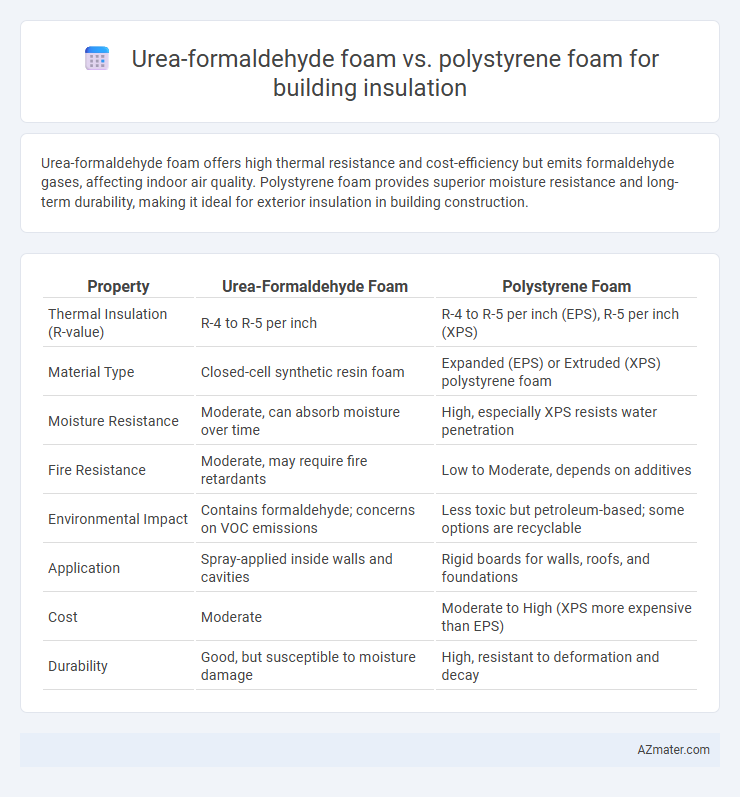Urea-formaldehyde foam offers high thermal resistance and cost-efficiency but emits formaldehyde gases, affecting indoor air quality. Polystyrene foam provides superior moisture resistance and long-term durability, making it ideal for exterior insulation in building construction.
Table of Comparison
| Property | Urea-Formaldehyde Foam | Polystyrene Foam |
|---|---|---|
| Thermal Insulation (R-value) | R-4 to R-5 per inch | R-4 to R-5 per inch (EPS), R-5 per inch (XPS) |
| Material Type | Closed-cell synthetic resin foam | Expanded (EPS) or Extruded (XPS) polystyrene foam |
| Moisture Resistance | Moderate, can absorb moisture over time | High, especially XPS resists water penetration |
| Fire Resistance | Moderate, may require fire retardants | Low to Moderate, depends on additives |
| Environmental Impact | Contains formaldehyde; concerns on VOC emissions | Less toxic but petroleum-based; some options are recyclable |
| Application | Spray-applied inside walls and cavities | Rigid boards for walls, roofs, and foundations |
| Cost | Moderate | Moderate to High (XPS more expensive than EPS) |
| Durability | Good, but susceptible to moisture damage | High, resistant to deformation and decay |
Introduction to Building Insulation Materials
Urea-formaldehyde foam and polystyrene foam are common insulation materials used in building construction, each offering distinct thermal properties and installation methods. Urea-formaldehyde foam insulation (UFFI) is a spray-applied, expanding foam known for its superior air-sealing capabilities and moderate R-values, typically around R-4 per inch. Polystyrene foam, available as expanded (EPS) or extruded (XPS), offers higher moisture resistance and R-values ranging from R-4 to R-5 per inch, making it a preferred choice for exterior wall and foundation insulation.
Overview of Urea-Formaldehyde Foam
Urea-formaldehyde foam (UFF) is a lightweight, rigid insulation material produced by reacting urea and formaldehyde resins, creating a closed-cell structure that offers effective thermal resistance. It provides a high R-value per inch, typically around R-5 to R-6, making it suitable for enhancing energy efficiency in building envelopes. While UFF is cost-effective and easy to install in cavities, concerns about formaldehyde emissions and moisture susceptibility require careful ventilation and application control.
Overview of Polystyrene Foam
Polystyrene foam, commonly available as expanded (EPS) or extruded (XPS) foam, is a widely used building insulation material known for its high thermal resistance and moisture resistance. Its closed-cell structure provides excellent insulation performance with R-values typically ranging from 3.6 to 5 per inch, making it effective for walls, roofs, and foundations. Polystyrene foam is lightweight, durable, and resistant to compression, offering long-term energy efficiency benefits in residential and commercial construction.
Thermal Efficiency Comparison
Urea-formaldehyde foam offers a higher R-value per inch, typically around 4.0 to 4.5, compared to polystyrene foam's R-value of 3.6 to 4.0, indicating superior thermal resistance and energy efficiency. The closed-cell structure of urea-formaldehyde enhances air sealing capabilities, reducing heat transfer and improving insulation performance in colder climates. Polystyrene foam, while durable and moisture-resistant, generally provides less insulation effectiveness, making urea-formaldehyde foam a preferred choice for maximizing thermal efficiency in building envelopes.
Moisture Resistance and Durability
Urea-formaldehyde foam offers moderate moisture resistance but can degrade over time when exposed to moisture, reducing its durability in humid environments. Polystyrene foam, particularly extruded polystyrene (XPS), provides superior moisture resistance due to its closed-cell structure, enhancing long-term durability and preventing water absorption. This makes polystyrene foam a preferred choice for insulation in areas prone to dampness or water exposure, ensuring sustained thermal performance and structural integrity.
Fire Safety and Toxicity Considerations
Urea-formaldehyde foam insulation releases toxic formaldehyde gas when exposed to fire, posing significant health hazards, whereas polystyrene foam can emit hazardous styrene and other toxic compounds during combustion. Polystyrene foam typically exhibits better fire resistance with appropriate flame retardants, while urea-formaldehyde foam is more prone to ignition and smoldering. Fire safety standards prefer polystyrene foam in building insulation for lower toxicity risks and improved flame retardancy under regulated conditions.
Installation Processes and Practicality
Urea-formaldehyde foam insulation (UFFI) involves spraying a liquid mixture that expands and hardens within wall cavities, requiring professional handling due to chemical off-gassing concerns, whereas polystyrene foam insulation, available as rigid boards or expanded beads, is simpler to cut and fit during installation. Polystyrene foam offers greater ease of installation in retrofit projects because of its lightweight and moisture resistance, while UFFI demands precise application to avoid gaps and maintains higher thermal efficiency in sealed environments. Practicality favors polystyrene in terms of installation speed and user safety, whereas UFFI provides superior airtightness but necessitates specialized skills and ventilation controls during application.
Environmental Impact and Sustainability
Urea-formaldehyde foam insulation has a higher environmental impact due to formaldehyde emissions, a volatile organic compound linked to indoor air quality concerns and potential health risks. Polystyrene foam, while non-toxic after curing, poses environmental challenges because it is derived from petroleum, is non-biodegradable, and contributes to long-term plastic pollution. Sustainable building practices increasingly favor materials with lower embodied energy and greater recyclability, positioning polystyrene foam as less eco-friendly compared to emerging bio-based insulation alternatives.
Cost Analysis and Long-Term Value
Urea-formaldehyde foam offers a lower initial cost compared to polystyrene foam, making it an attractive choice for budget-conscious construction projects. Polystyrene foam, while typically more expensive upfront, provides superior long-term value due to its higher durability, moisture resistance, and insulation efficiency. Over the lifespan of a building, polystyrene foam often results in lower maintenance costs and better energy savings, offsetting the initial investment.
Conclusion: Choosing the Right Foam for Your Project
Urea-formaldehyde foam offers excellent thermal insulation and superior soundproofing but may release formaldehyde gases, requiring careful ventilation during installation. Polystyrene foam provides high moisture resistance, durability, and ease of installation, making it ideal for moisture-prone areas and long-term performance. Selecting the right foam depends on project-specific factors such as environmental conditions, budget constraints, and health safety priorities.

Infographic: Urea-formaldehyde foam vs Polystyrene foam for Building Insulation
 azmater.com
azmater.com